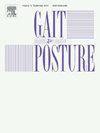Measuring static and dynamic lower limb alignment in patients with advanced knee osteoarthritis using markerless motion capture
IF 2.2
3区 医学
Q3 NEUROSCIENCES
引用次数: 0
Abstract
Purpose
Marked lower limb malalignment is associated with the progression of knee osteoarthritis (OA). Markerless motion capture is a computer-vision tool that can measure lower limb alignment throughout both static and dynamic tasks.
Research questions
The primary objective of the study was to quantify static and dynamic lower limb alignment for patients diagnosed with advanced medial and lateral knee OA. This analysis also explored sex differences in alignment from the static and dynamic tasks. The secondary objective was to investigate if the mean knee adduction angle during quiet standing and the peak knee adduction angle during the first half of stance of gait were associated.
Methods
Ninety-two patients (37 male, 55 female) diagnosed with advanced knee OA (83 with predominantly medial knee OA, and 9 with predominantly lateral knee OA) completed a quiet standing task and a gait task for markerless motion capture using Theia3D software. Two-way analysis of variance tests were used to investigate sex differences and unpaired t-tests were computed to compare knee OA groups.
Results
Statistically significant differences in the knee adduction angle were found between medial and lateral knee OA groups during quiet standing (p < 0.001) and the first half of stance of gait (p < 0.0001). A strong correlation was found (Spearman’s ρ = 0.86, p < 0.0001) in lower limb alignment between the static and gait tasks.
Significance
These results show how markerless technology was able to quantify lower limb alignment and demonstrates potential for integration into clinic to assess musculoskeletal diseases.
使用无标记运动捕捉测量晚期膝关节骨性关节炎患者的静态和动态下肢对齐
目的:明显的下肢错位与膝骨关节炎(OA)的进展有关。无标记动作捕捉是一种计算机视觉工具,可以在静态和动态任务中测量下肢对齐。研究问题本研究的主要目的是量化诊断为晚期内侧和外侧膝OA的患者的静态和动态下肢对齐。该分析还从静态任务和动态任务两方面探讨了性别差异。次要目的是研究安静站立时的平均膝关节内收角与站立步态前半段的膝关节内收角峰值是否相关。方法92例晚期膝关节OA患者(男37例,女55例)(83例以膝关节内侧OA为主,9例以膝关节外侧OA为主)使用Theia3D软件完成安静站立任务和无标记动作捕捉的步态任务。使用双向方差分析检验来调查性别差异,使用非配对t检验来比较膝关节OA组。结果静站立时(p <; 0.001)和站立前半步时(p <; 0.0001)膝关节内收角在内侧组和外侧组之间差异有统计学意义。静态任务和步态任务之间的下肢对齐存在很强的相关性(Spearman 's ρ = 0.86, p <; 0.0001)。这些结果显示了无标记技术如何能够量化下肢对齐,并展示了整合到临床评估肌肉骨骼疾病的潜力。
本文章由计算机程序翻译,如有差异,请以英文原文为准。
求助全文
约1分钟内获得全文
求助全文
来源期刊

Gait & posture
医学-神经科学
CiteScore
4.70
自引率
12.50%
发文量
616
审稿时长
6 months
期刊介绍:
Gait & Posture is a vehicle for the publication of up-to-date basic and clinical research on all aspects of locomotion and balance.
The topics covered include: Techniques for the measurement of gait and posture, and the standardization of results presentation; Studies of normal and pathological gait; Treatment of gait and postural abnormalities; Biomechanical and theoretical approaches to gait and posture; Mathematical models of joint and muscle mechanics; Neurological and musculoskeletal function in gait and posture; The evolution of upright posture and bipedal locomotion; Adaptations of carrying loads, walking on uneven surfaces, climbing stairs etc; spinal biomechanics only if they are directly related to gait and/or posture and are of general interest to our readers; The effect of aging and development on gait and posture; Psychological and cultural aspects of gait; Patient education.
 求助内容:
求助内容: 应助结果提醒方式:
应助结果提醒方式:


